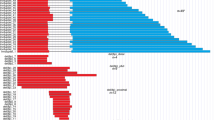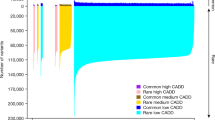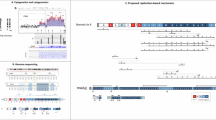Abstract
It has been proposed that duplications of 8p23.1 are either euchromatic variants of the 8p23.1 defensin domain with no phenotypic consequences or true duplications associated with developmental delay and heart defects. Here, we provide evidence for both alternatives in two new families. A duplication of most of band 8p23.1 (circa 5 Mb) was found in a girl of 8 years with pulmonary stenosis and mild language delay. BAC fluorescence in situ hybridisation (FISH) and multiplex amplifiable probe hybridisation (MAPH) showed that the two copies of the duplicated segment were sited, in an alternating fashion, between three copies of a circa 300–450 kb segment from 8p23.1 distal to REPD. Copy number of the variable 8p23.1 defensin domain was consistent with duplication but within the normal range. Duplication of the GATA-binding protein 4 gene (GATA4) in this patient and others with and without heart defects, suggests it is a dosage-sensitive gene with variable penetrance. A cytogenetically similar duplication of 8p23.1 was found at prenatal diagnosis in a fetus, father and grandmother. There was no duplication using BAC FISH but MAPH showed 11 copies of the 360 kb variable defensin domain which is within the expanded range found in previous euchromatic variant carriers. Semiquantitative FISH (SQ-FISH) was consistent with a simultaneous expansion of the adjacent olfactory receptor repeats. These results distinguish duplications of 8p23.1 with clinically significant consequences from benign copy number variants, which have not yet been associated with qualitative or quantitative traits.
Similar content being viewed by others
Log in or create a free account to read this content
Gain free access to this article, as well as selected content from this journal and more on nature.com
or
References
Barber JCK, Joyce CA, Collinson MN et al: Duplication of 8p23.1: a cytogenetic anomaly with no established clinical significance. J Med Genet 1998; 35: 491–496.
O’Malley DP, Storto PD : Confirmation of the chromosome 8p23.1 euchromatic duplication as a variant with no clinical manifestations. Prenat Diagn 1999; 19: 178–185.
Begleiter ML, Cooper HA, Paszfor LM, Butler MG : Chromosome 8p23.1 duplication: is there an association with a clinical phenotype? Am J Hum Genet 2000; 65: A158,858.
Gibbons B, Tan SY, Barber JCK et al: Duplication of 8p with minimal phenotypic effect transmitted from a mother to her two daughters. J Med Genet 1999; 36: 419–422.
Hollox EJ, Armour JAL, Barber JCK : Extensive normal copy number variation of a β-defensin antimicrobial gene cluster. Am J Hum Genet 2003; 73: 591–600.
Kennedy SJ, Teebi AS, Adatia I, Teshima I : Inherited duplication, dup(8)(p23.1p23.1) pat, in a father and daughter with congenital heart defects. Am J Med Genet 2001; 104: 79–80.
Kondoh T, Takano J, Sugawara H et al: Clinical manifestations of Coffin–Lowry syndrome associated with de novo 8p23 duplication. Am J Hum Genet 2001; 69: A646.
Tsai C-H, Graw SL, McGavran L : 8p23 duplication reconsidered: is it a true euchromatic variant with no clinical manifestation? J Med Genet 2002; 39: 769–774.
National Institutes of Health and Institute of Molecular Medicine Collaboration: A complete set of human telomeric probes and their clinical application. Nat Genet 1996; 14: 86–89.
Trask BJ, Massa H, Brand-Arpon V et al: Large multi-chromosomal duplications encompass many members of the olfactory receptor gene family in the human genome. Hum Mol Genet 1998; 13: 2007–2020.
Giglio S, Broman KW, Matsumoto N et al: Olfactory receptor-gene clusters, genomic-inversion polymorphisms, and common chromosome rearrangements. Am J Hum Genet 2001; 68: 874–883.
Taudien S, Galgoczy P, Huse K et al: Polymorphic segmental duplications at 8p23.1 challenge the determination of individual defensin gene repertoires and the assembly of a contiguous human reference sequence. BMC Genomics 2004; 10: 92.
Fan Y-S, Siu VM, Jung JH, Farrell SA, Cote GB : Direct duplication of 8p21.3–p23.1: a cytogenetic anomaly associated with developmental delay without consistent clinical features. Am J Med Genet 2001; 103: 231–234.
Engelen JJM, de Die-Smulders CEM, Sijstermans JMJ, Meers LEC, Albrechts JCM, Hamers AJH : Familial partial trisomy 8p without dysmorphic features and only mild mental retardation. J Med Genet 1995; 32: 792–795.
Milunsky JM, Huang XL : Unmasking Kabuki syndrome: chromosome 8p22–8p23.1 duplication revealed by comparative genomic hybridisation and BAC-FISH. Clin Genet 2003; 64: 509–516.
Miyake N, Harada N, Shimokawa O et al: On the reported 8p22–p23.1 duplication in Kabuki make-up syndrome (KMS) and its absence in patients with typical KMS. Am J Med Genet 2004; 128A: 170–172.
Engelen JJM, Moog U, Evers JLH, Dassen H, Albrechts JCM, Hamers AJH : Duplication of chromosome region 8p23.1–>p23.3: a benign variant? Am J Med Genet 2000; 91: 18–21.
Harada N, Takano J, Kondoh et al: Duplication of 8p23.2: a benign cytogenetic variant? Am J Med Genet 2002; 111: 285–288.
Pehlivan T, Pober BR, Brueckner M et al: GATA4 haploinsufficiency in patients with interstitial deletion of chromosome region 8p23.1 and congenital heart disease. Am J Med Genet 1999; 83: 201–206.
Garg V, Kathiriya IS, Barnes R et al: GATA4 mutations cause human congenital heart defects and reveal an interaction with TBX5. Nature 2003; 424: 443–444.
Devriendt K, Matthijs G, Van Dael R et al: Delineation of the critical deletion region for congenital heart defects on chromosome 8p23.1. Am J Hum Genet 1999; 64: 1119–1126.
Giglio S, Graw SL, Gimelli G et al: Deletion of a 5-cM region at chromosome 8p23 is associated with a spectrum of congenital heart defects. Circulation 2000; 102: 432–437.
Barber JCK, Cross IE, Douglas F, Nicholson JC, Moore KJ, Browne CE : Neurofibromatosis pseudogene amplification underlies euchromatic cytogenetic duplications and triplications of proximal 15q. Hum Genet 1998; 103: 600–608.
Barber JCK, Reed CJ, Dahoun SP, Joyce CA : Amplification of a pseudogene cassette underlies euchromatic variation of 16p at the cytogenetic level. Hum Genet 1999; 104: 211–218.
Sebat J, Lakshmi B, Troge J et al: Large-scale copy number polymorphism in the human genome. Science 2004; 305: 525–528.
Iafrate AJ, Feuk L, Rivera MN et al: Detection of large-scale variation in the human genome. Nat Genet 2004; 36: 949–951.
Acknowledgements
We are indebted to the patients who contributed additional samples and photographs. We are grateful to the Sanger Centre for providing the Ensembl tiling path clones and to Dr Hiroaki Shizuya for kindly providing BAC 51D11. VM is supported as part of the National Genetics Reference Laboratory (Wessex) by the UK Department of Health Genetics, Embryology and Assisted Conception Unit and TL was supported in parts by the Dr Robert Pfleger-Stiftung fund. EJH is supported by a Welcome Trust Bioarchaeology Postdoctoral Fellowship (Grant no. 071024). The image enhancement equipment used for parts of this work was provided by the Wellcome Trust and Trust Funds of Salisbury NHS Health Care Trust. Finally, we thank Simon Thomas for his constructive reading of the manuscript.
Author information
Authors and Affiliations
Corresponding author
Additional information
URLs
Ensembl tiling path (www.ensembl.org/homo_sapiens/cytoview), Database of Genomic Variants (http://projects.tcag.ca/variation/)
Rights and permissions
About this article
Cite this article
Barber, J., Maloney, V., Hollox, E. et al. Duplications and copy number variants of 8p23.1 are cytogenetically indistinguishable but distinct at the molecular level. Eur J Hum Genet 13, 1131–1136 (2005). https://doi.org/10.1038/sj.ejhg.5201475
Received:
Revised:
Accepted:
Published:
Issue date:
DOI: https://doi.org/10.1038/sj.ejhg.5201475
Keywords
This article is cited by
-
Prenatal and postnatal diagnoses and phenotype of 8p23.3p22 duplication in one family
BMC Medical Genomics (2021)
-
De novo vs. inherited copy number variations in multiple sclerosis susceptibility
Cellular & Molecular Immunology (2018)
-
3‐Hydroxyisobutyrate aciduria and mutations in the ALDH6A1 gene coding for methylmalonate semialdehyde dehydrogenase
Journal of Inherited Metabolic Disease (2012)
-
Genomic profile of copy number variants on the short arm of human chromosome 8
European Journal of Human Genetics (2010)
-
Transmitted duplication of 8p23.1–8p23.2 associated with speech delay, autism and learning difficulties
European Journal of Human Genetics (2009)



